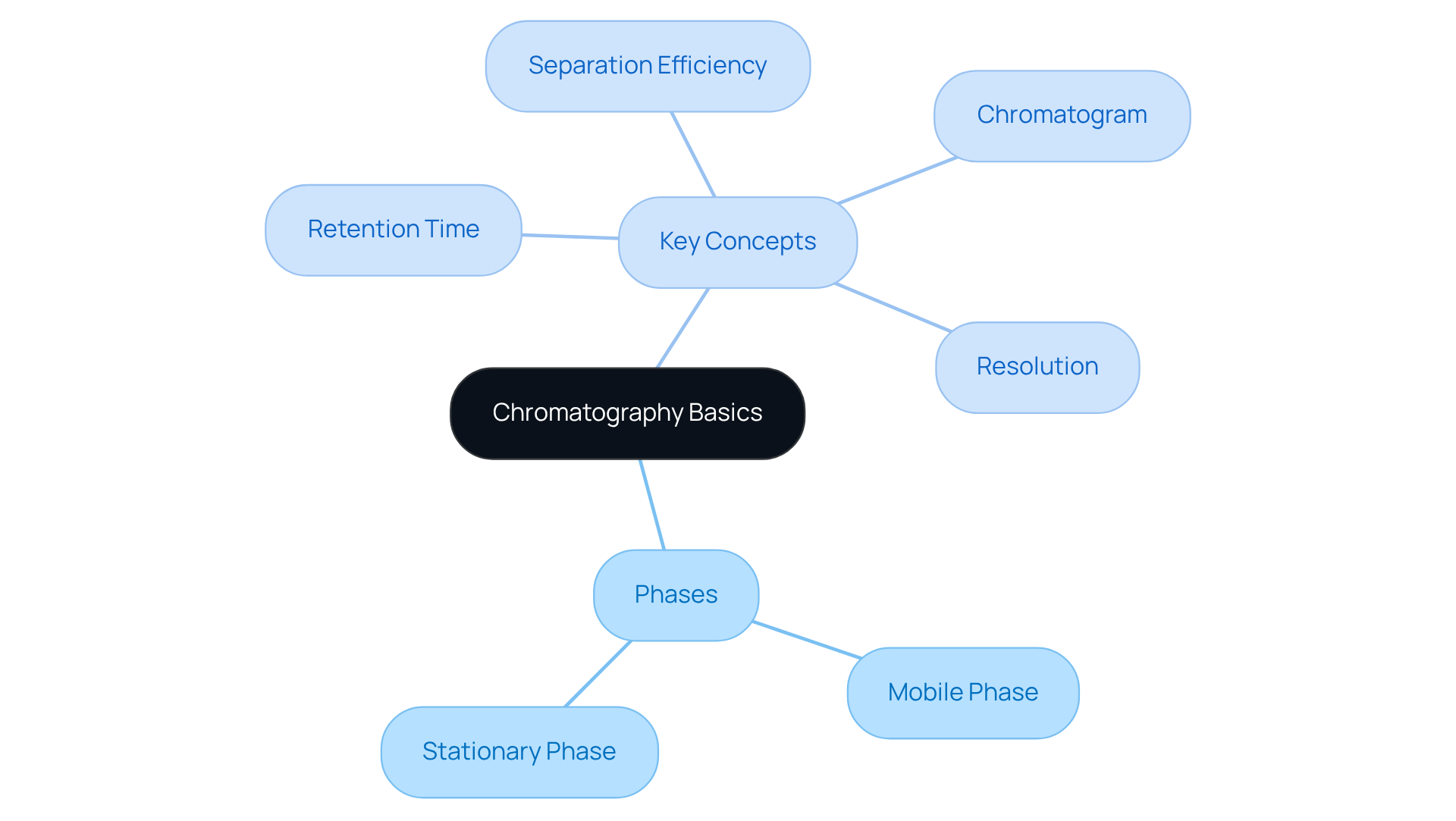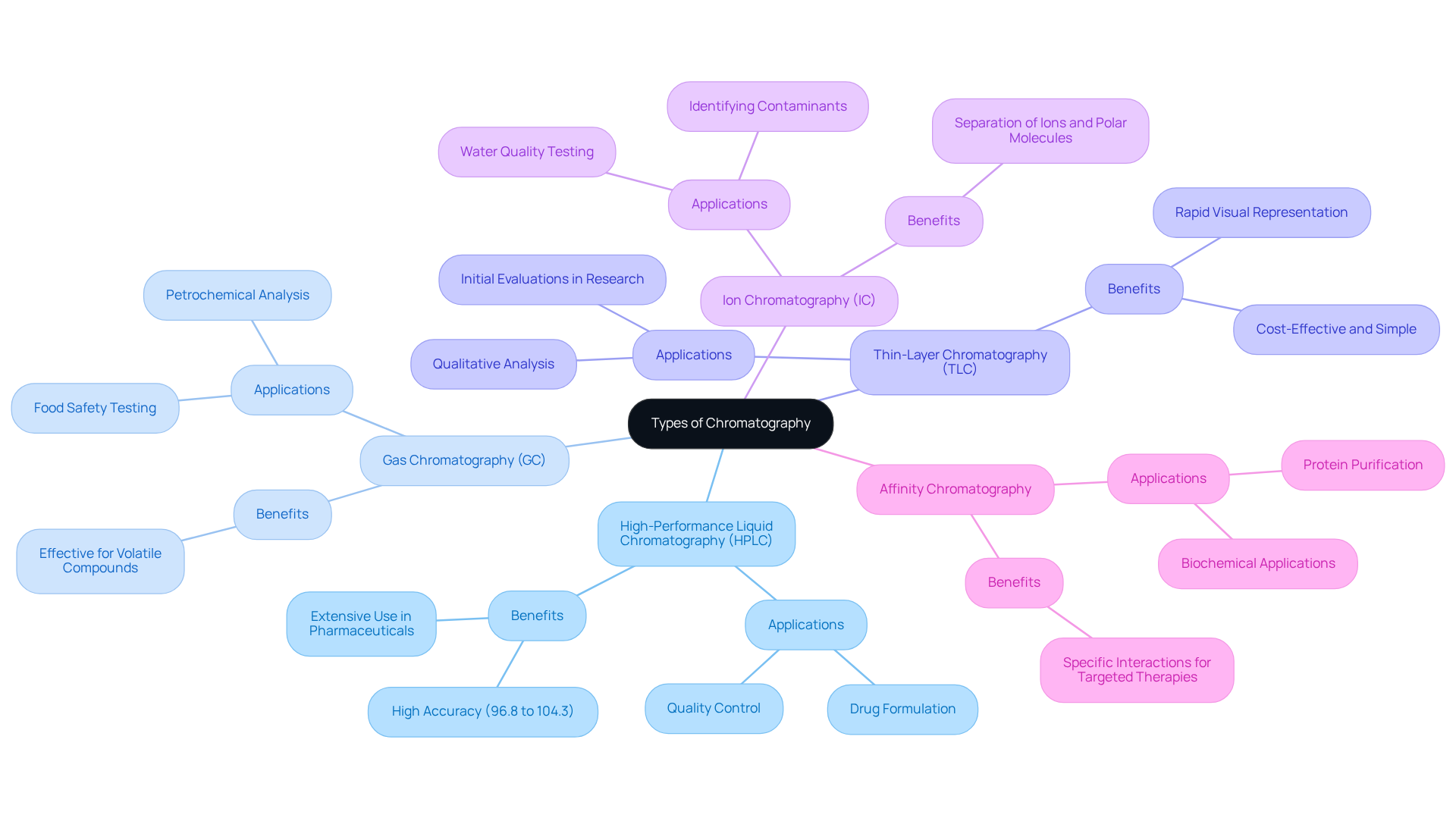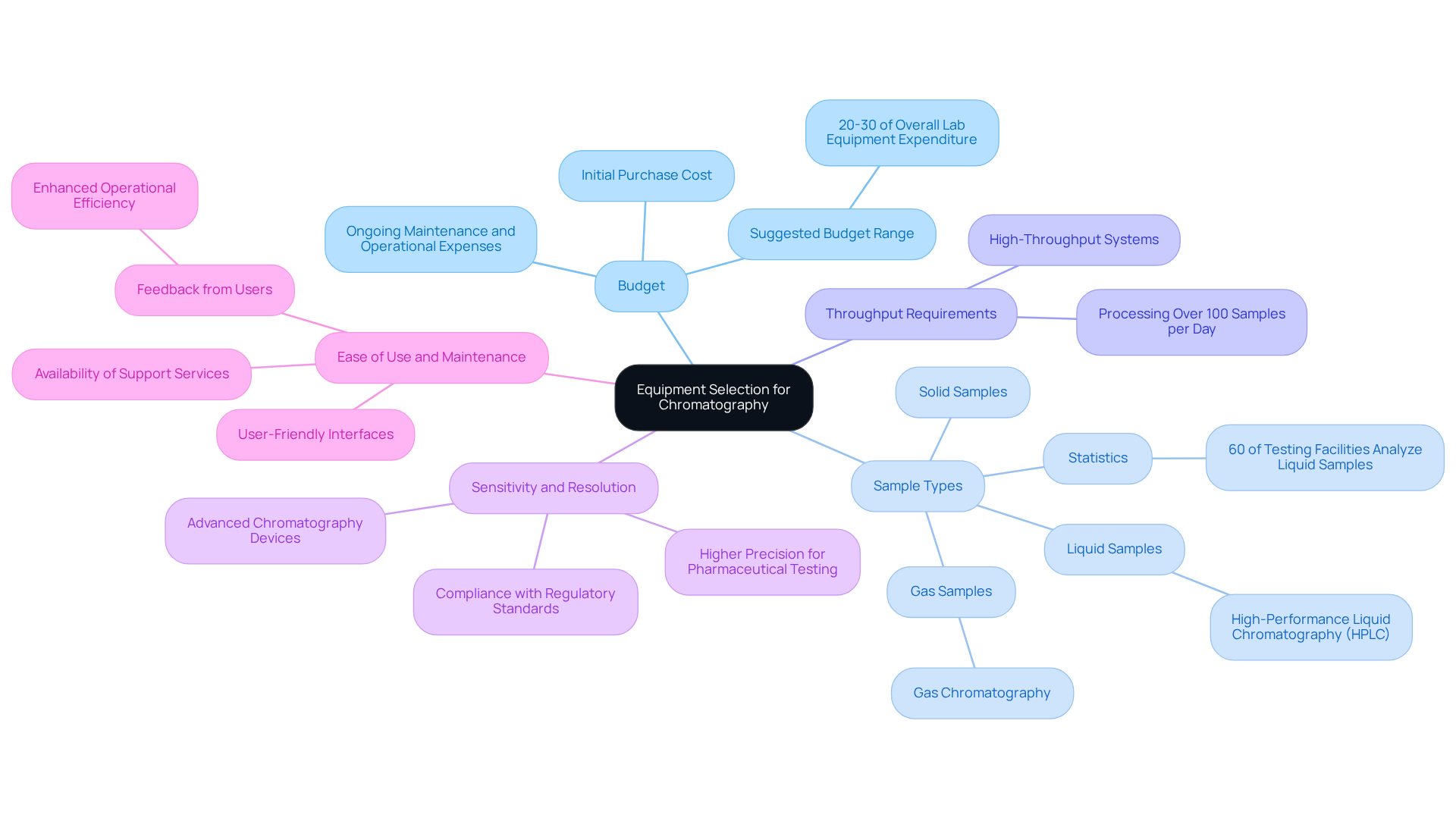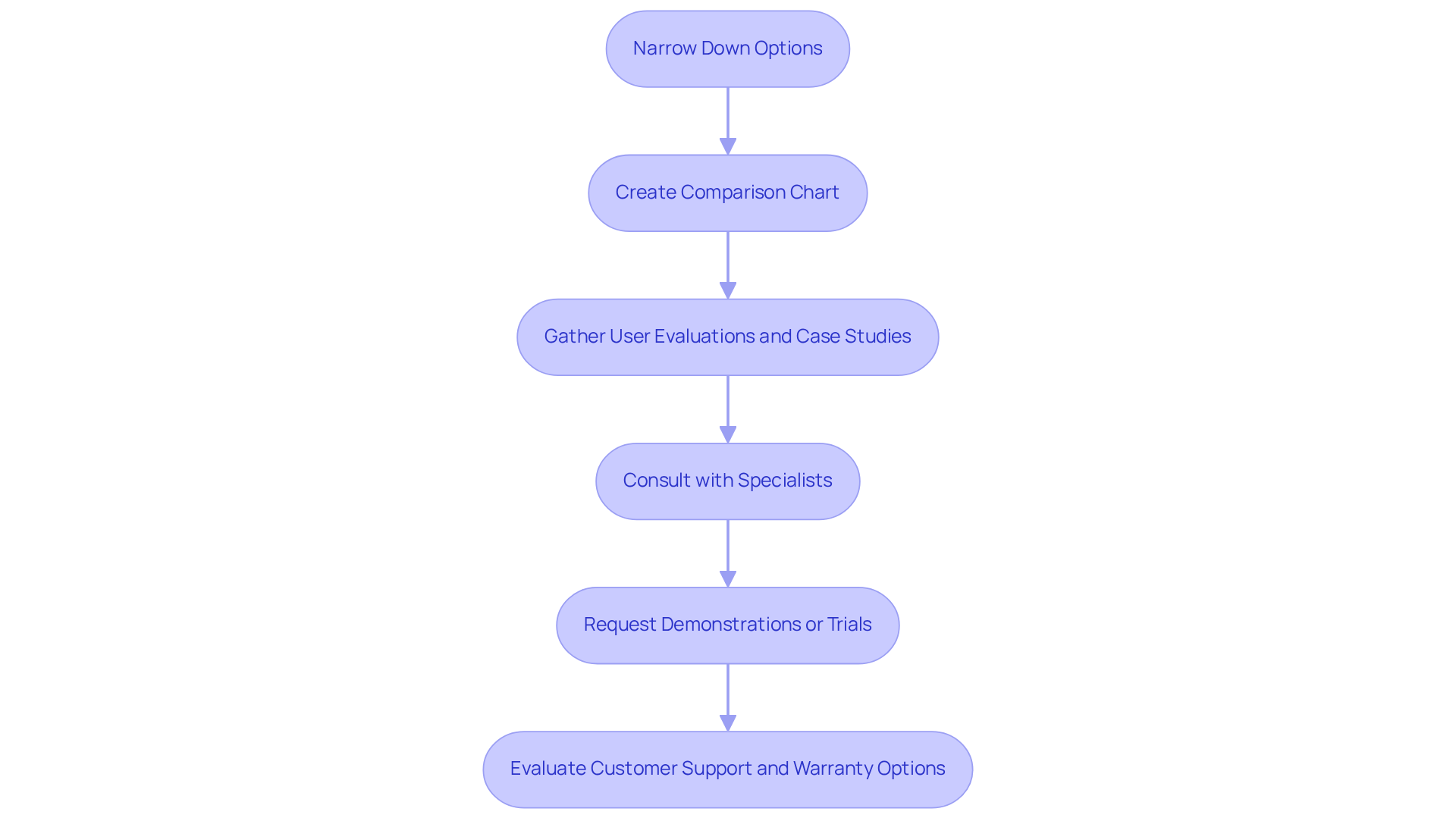Overview
Choosing the right chromatography device for your lab requires a thorough evaluation of several key considerations:
- Budget
- Sample types
- Throughput requirements
- Sensitivity and resolution
- Ease of use
Understanding the fundamentals of chromatography is crucial, as it allows for a systematic approach to selecting the appropriate equipment. By comparing devices based on specifications and real-world performance, you can ensure that the chosen device aligns with your laboratory's specific analytical needs. This careful selection process not only enhances the efficiency of your laboratory operations but also reinforces the importance of investing in high-quality scientific instruments.
Introduction
Selecting the right chromatography device presents a significant challenge for laboratory managers, given the multitude of techniques and technologies at their disposal today. A comprehensive understanding of the fundamental principles of chromatography is crucial, as it establishes the foundation for informed decision-making that can enhance analytical capabilities. With a variety of chromatography types—each tailored for specific applications—how can one adeptly navigate the complexities of equipment selection?
This guide elucidates the essential steps and considerations required to select the most appropriate chromatography device for any laboratory, ensuring optimal performance and reliability in analytical tasks.
Understand Chromatography Basics
Chromatography stands as a fundamental technique for separating mixtures into their distinct components. This process encompasses two phases: the mobile phase, responsible for transporting the mixture, and the stationary phase, which interacts with the mixture's components. A solid grasp of the fundamentals of this analytical technique—such as retention time, separation efficiency, and the dynamics between the mobile and stationary phases—is crucial for selecting the right device for your laboratory.
JM Science Inc. offers a comprehensive range of high-quality scientific instruments, including high-performance liquid columns and accessories, essential for achieving optimal separation and analysis in your lab. Terms such as 'chromatogram,' the visual output of a chromatography run, and 'resolution,' which quantifies the ability to distinguish between various components, are integral to this understanding.
For example, in practical applications, retention time can significantly impact separation quality, thereby influencing the overall analysis. By familiarizing yourself with these concepts, you will streamline your equipment selection process and enhance your laboratory's analytical capabilities.

Explore Different Types of Chromatography
A chromatography device encompasses a range of techniques, each tailored for specific applications. The most prevalent types include:
-
High-Performance Liquid Chromatography: This technique is renowned for its precision in separating and analyzing compounds in liquid samples, making it extensively utilized in pharmaceuticals for drug formulation and quality control. JM Science Inc. offers a variety of high-performance liquid chromatography columns and accessories, including Shodex, CapcellPak, and Reprosil columns, designed to meet the stringent requirements of pharmaceutical applications. The reliability of high-performance liquid chromatography is underscored by its ability to achieve accuracy values ranging from 96.8% to 104.3% for various drug concentrations.
-
Gas Chromatography (GC): Essential for analyzing volatile compounds, GC is a staple in the petrochemical and food industries. For instance, it is employed in food safety testing to detect contaminants and ensure compliance with health regulations.
-
Thin-Layer Chromatography (TLC): As a simple and economical technique, TLC is frequently utilized for qualitative analysis in educational settings and initial evaluations in research facilities, providing a rapid visual representation of compound separation.
-
Ion Chromatography (IC): This technique is specifically designed for the separation of ions and polar molecules, proving particularly valuable in water quality testing, where it aids in identifying contaminants and assessing compliance with environmental standards.
-
Affinity Chromatography: Leveraging specific interactions between molecules, this specialized method is indispensable for protein purification and biochemical applications, especially in the development of targeted therapies in pharmaceuticals.
In addition to the high-performance liquid chromatography device, JM Science also supplies titrators and Karl Fischer reagents, which are crucial for various analytical applications in laboratories. Recent advancements in high-performance liquid chromatography systems, including those provided by JM Science, enable operation at pressures up to 120 MPa, allowing for the use of smaller particle sizes that enhance separation efficiency. As noted by industry experts, "HPLC plays a crucial role in ensuring product purity in pharmaceutical development, making it an essential tool for lab managers."
By understanding these separation techniques and the additional products offered by JM Science, you can more effectively evaluate which method aligns with your laboratory's analytical needs, ensuring optimal performance and outcomes.

Evaluate Key Considerations for Equipment Selection
When choosing a chromatography device, several critical factors must be taken into account to ensure optimal performance and value for your laboratory.
-
Budget: It is crucial to define your budget limitations, as separation equipment can differ significantly in cost. Consider not only the initial purchase cost but also ongoing maintenance and operational expenses, which can significantly impact your overall investment. Laboratories frequently encounter difficulties in maintaining a balance between quality and expenses, with numerous managers suggesting a budget range of 20-30% of their overall lab equipment expenditure for separation devices.
-
Sample Types: Clearly identifying the types of samples you will be analyzing is essential. Various separation techniques accommodate different sample types, including liquids, gases, and solids. For instance, high-performance liquid separation is ideal for liquid samples, while gas chromatography excels with volatile compounds. Recent statistics indicate that approximately 60% of testing facilities primarily analyze liquid samples, making HPLC a popular choice.
-
Throughput Requirements: Assessing your facility's throughput needs is vital. If your lab processes a high volume of samples, investing in high-throughput systems may be necessary to maintain efficiency and meet deadlines. Laboratory managers have noted that systems capable of processing over 100 samples per day are essential for busy environments.
-
Sensitivity and Resolution: Evaluating the sensitivity and resolution required for your specific analyses is crucial. Certain applications, such as pharmaceutical testing, demand higher precision, necessitating advanced chromatography devices that can deliver the required performance. A facility manager recently stated, "Investing in high-resolution systems has been crucial for our compliance with stringent regulatory standards."
-
Ease of Use and Maintenance: Consider the user-friendliness of the equipment and the availability of support and maintenance services. Devices that are simpler to use and maintain can save valuable time and decrease the chances of mistakes, thereby improving overall productivity in the lab. Feedback from users often highlights that systems with intuitive interfaces and robust support networks significantly enhance operational efficiency.
By thoroughly assessing these factors, you can effectively narrow down your choices and select an analytical instrument that aligns with your laboratory's specific requirements and financial limitations.

Assess and Compare Chromatography Devices
After narrowing down your options, it is essential to evaluate and contrast the chromatography device on your shortlist. Begin by creating a comparison chart that lists the key specifications and features of each item, including:
- Price
- Sensitivity
- Resolution
- Throughput capabilities
This foundational step will provide a clear overview of your options.
Next, delve into user evaluations and case studies that highlight the performance of each item in real-world applications. These insights can be invaluable, offering a glimpse into the reliability and ease of use of the equipment you are considering. Furthermore, if possible, consult with colleagues or industry specialists who have experience with the equipment. Their insights can illuminate the pros and cons of each option, enriching your understanding of the available choices.
Consider requesting demonstrations or trials of the equipment whenever feasible. Hands-on experience can be crucial in assessing usability and performance, allowing you to gauge how well the equipment meets your laboratory's needs. Additionally, evaluate the level of customer support and warranty options provided by the manufacturer. Reliable support is essential for troubleshooting and maintenance, ensuring the longevity of your investment.
By following these steps, you will be well-equipped to make a well-informed decision and choose the chromatography device that best aligns with your laboratory's requirements.

Conclusion
Selecting the appropriate chromatography device is a critical decision that can greatly enhance a laboratory's analytical capabilities. By comprehending the fundamentals of chromatography, examining various techniques, and assessing essential considerations, laboratories can ensure they choose the most fitting equipment for their specific requirements.
This article details vital steps, including:
- Understanding chromatography basics
- Identifying techniques such as high-performance liquid chromatography and gas chromatography
- Evaluating key factors like budget, sample types, and throughput demands
Each of these elements is crucial in guiding lab managers toward informed decisions that align with their operational objectives.
Ultimately, the choice of chromatography devices transcends mere preference; it is a strategic decision that significantly influences the accuracy and efficiency of laboratory outcomes. By applying the best practices discussed, laboratories can refine their equipment selection process, resulting in enhanced performance and adherence to industry standards. Embracing these insights empowers lab professionals to make decisions that not only address current demands but also anticipate future needs in an ever-evolving field.




